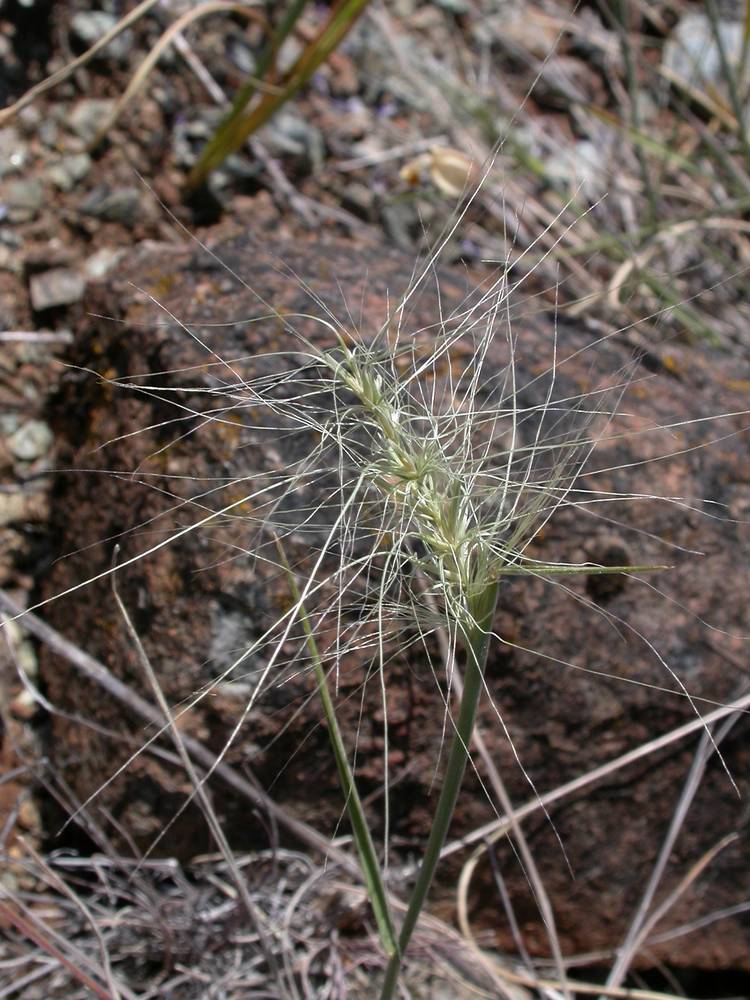Elymus multisetus
Elymus x saundersii
big squirreltail
Saunder's wildrye
erect to ascending.
erect, glabrous or pilose.
sheaths glabrous or white-villous;
blades 1.5–4 mm wide;
upper surfaces scabrous or hairy.
somewhat basally concentrated;
sheaths retrorsely hairy;
blades 10– 15 cm × 2.5–5 mm; flat, scabrous below; smooth above.
5–20 cm; erect, sometimes partially enclosed in the sheath of the uppermost leaf, 2 spikelets per node or rarely 3–4 at some nodes;
internodes 3–5(8)mm;
disarticulation initially at the rachis nodes; later beneath each floret.
(4)10–25 cm × 2–3 mm excluding the awns, 3–7 mm wide including the awns, 1 spikelet per node;
internodes 2.5–11 mm;
disarticulation at the rachis nodes.
10–15 mm, divergent, 2–4 florets; lowest florets sterile and glume-like in 1 or both spikelets at each node.
10–25 mm excluding the awns, 2–6 florets.
(10)30–100 mm including the awns; the bases hard and glabrous;
glume bodies about (2)5–10 × 1–2 mm, setaceous, 2–3-veined;
margins firm;
glume awns (8)25–90 mm; each split above the base into 3–9 unequal divisions, scabrous, flexuous to outcurving from near the bases at maturity.
6–8 × 0.8–1.2 mm, linear-lanceolate to lanceolate; (1)3(5)-veined;
veins scabrous;
tips sometimes toothed;
glume awns 0–5(13) mm.
fertile lemmas 8–10 mm; smooth or scabrous near the tips, 2 lateral veins extending into bristles to 10 mm;
lemma awns (10)20– 110 × 0.2 mm at the base, divergent to arching.
9.5–13 mm, glabrous; smooth proximally, scabrous distally; the lowest lemma often reduced and glume-like;
lemma awns 6–20(45)mm; straight to outcurving.
1–2 mm.
1.5–2.6 mm, usually indehiscent.
=28.
Elymus multisetus
Elymus x saundersii
Dry, often rocky grasslands and savannas. 50–2000m. BR, Col, ECas, Lava, Sisk, WV. CA, ID, NV, WA; southeast to CO, south to Mexico. Native.
Elymus multisetus has inflorescences that fall apart at maturity and glumes that are divided into three to nine widely spreading awns. Very similar E. elymoides has glumes that are entire or unevenly split into two to three parts. Determining how much the glumes are split is complicated by the presence of glumelike sterile lemmas in both E. multisetus and some E. elymoides subspecies. Elymus multisetus glumes are divided above the base. If the glumes appear to be divided to the base, the plant is more likely to be E. elymoides.
Open, dry to mesic habitats. 1700–2100m. BR, Col, ECas. CA, ID, NV; east to WY, southeast to CO and NM. Native.
Elymus × saundersii is a hybrid of E. trachycaulus and E. elymoides or E. multisetus. It is recognized by its cespitose habitat and an inflorescence axis that disarticulates and has one spikelet per node. This hybrid resembles Pseudelymus saxicola but has awns that are shorter and spread only slightly. This hybrid may be more variable than the description suggests.
Barbara Wilson, Richard Brainerd, Nick Otting
Barbara Wilson, Richard Brainerd, Nick Otting
- Local floras:
CA,
OR,
WA
- Local Web sites:
CalFlora,
CalPhotos,
Flora NW,
PNW Herbaria
WildflowerSearch
iNaturalist (observations)
USDA Plants Database
- LBJ Wildflower Center
- SEINet
- Plants of the World Online
- Encyclopedia of Life
- Wikipedia
- Google Image Search




